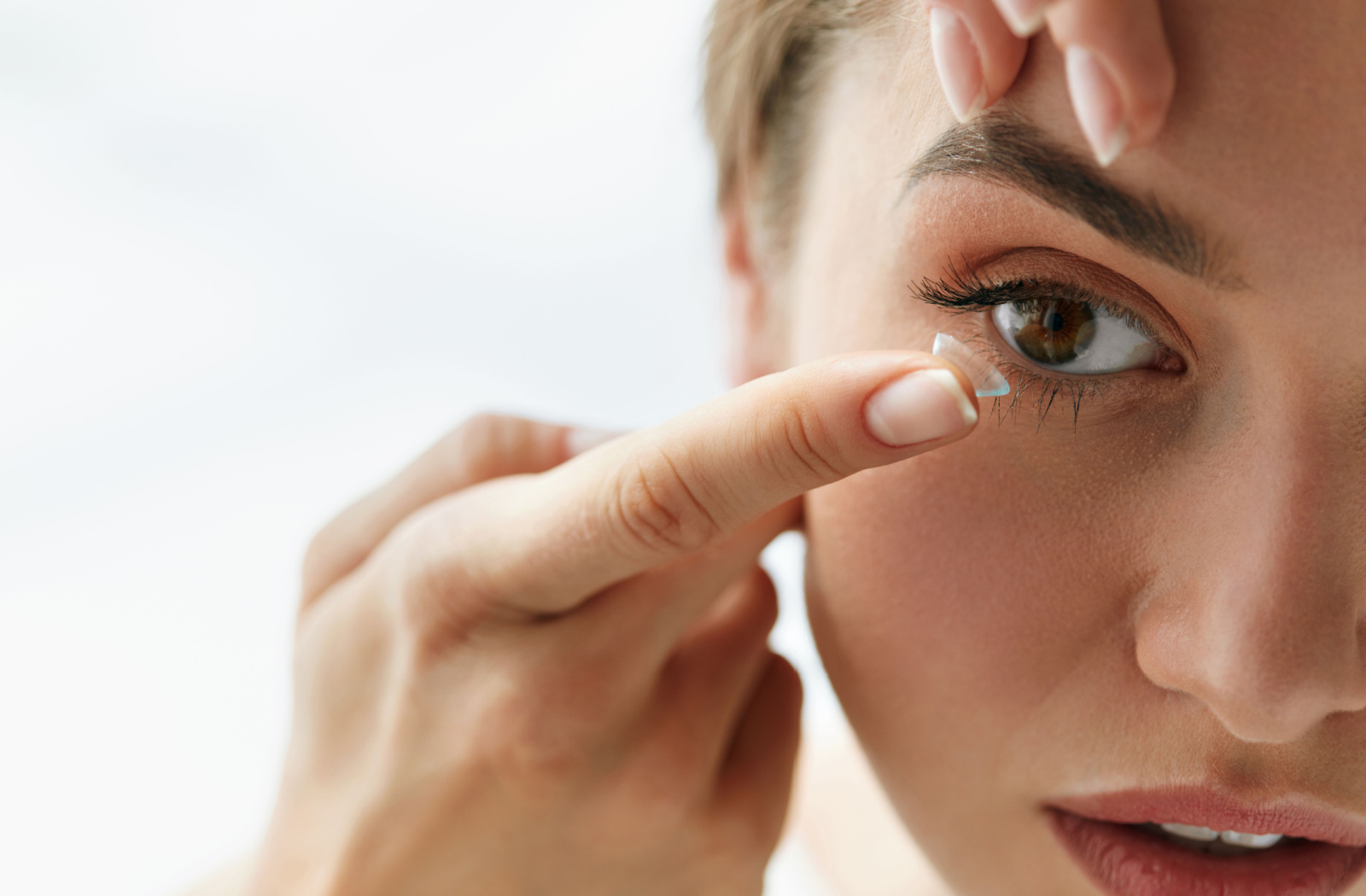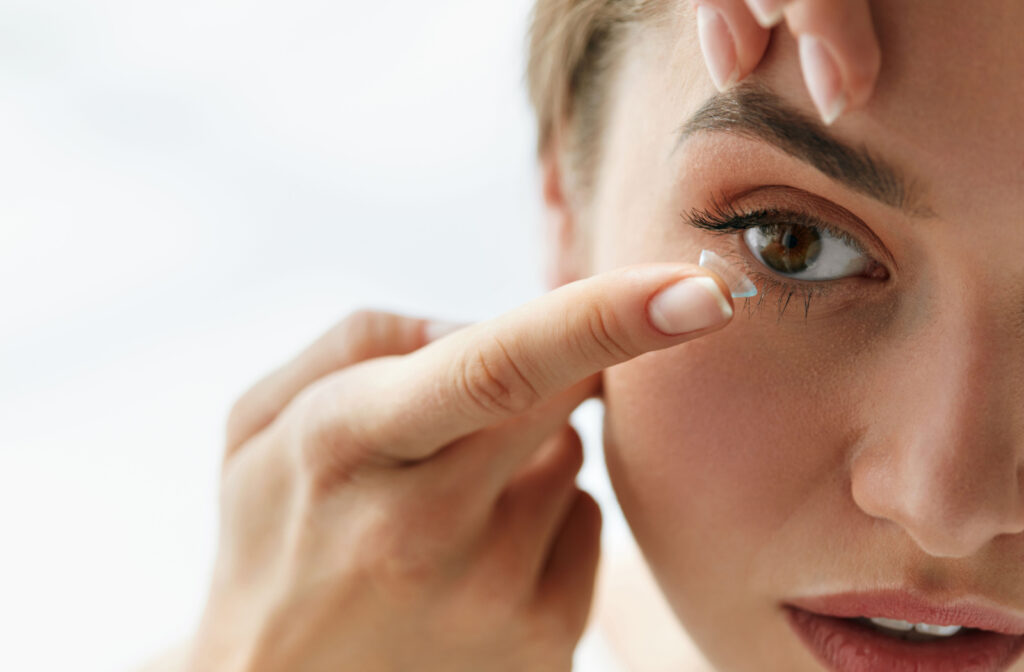For those who adore the convenience of contact lenses, grappling with dry eyes can feel like a daunting barrier to clear vision. The relationship between them can be complex. Dry eye can indeed make wearing contacts uncomfortable, just as contacts can dry out your eyes. But that’s not the end of the story.
You can wear contacts with dry eyes with proper treatment, some simple moisture management, and specialty lenses. It all starts with understanding where this dryness comes from.
What Are Dry Eyes?
Dry eyes occur when your eyes do not produce enough tears or when the tears are of poor quality and evaporate too quickly. This imbalance can lead to symptoms such as:
- Discomfort
- Scratchy, gritty, or burning sensation in the eyes
- Red eyes
- Excessive tearing
- Blurry vision
- Sensitivity to light
- Eye fatigue
- Difficulty wearing contact lenses
It’s a condition that reminds us how essential a well-functioning tear film is to nourish and protect our eyes.
Common Causes of Dry Eyes
Identifying your dry eyes’ root causes is pivotal for effectively managing the symptoms. Moreover, it can help us determine if you can still enjoy the benefits of contacts.
Environmental Factors
Your surroundings play a significant role in eye moisture. Air pollution, harsh winds, and a dry climate can increase tear evaporation. Simple environmental changes, like using a humidifier or wearing protective eyewear, can offer relief.
Aging & Hormonal Changes
As we age, tear production often diminishes. This can be particularly severe among females experiencing hormonal changes, such as those associated with menopause. Understanding this natural progression empowers us to seek appropriate solutions.
Medications & Medical Conditions
Certain medications and medical conditions can reduce tear production or affect their composition. Common medications that can reduce tear production include:
- Antihistamines
- Decongestants
- Blood pressure medication
- Antidepressants
The medical conditions that can affect your tears are surprisingly varied. Conditions like rheumatoid arthritis, diabetes, thyroid problems, and Sjögren’s syndrome can reduce the amount of tears you produce. Meanwhile, eyelid inflammations like blepharitis can block oil glands and result in meibomian gland dysfunction (MGD), the most common cause of dry eyes.
Prolonged Digital Device Use
Our modern lifestyle has us locked onto screens for extended periods — a habit that can strain our eyes. Reducing screen time and taking regular breaks to blink and rest your eyes are small steps with significant impact.
Why Dry Eye Is Worse After Waking Up
Many people notice their dry eye symptoms intensify upon waking. The reason can be a combination of every other factor at once.
Your bedroom could be dry and need a humidifier, or you could have a medical condition where your eyes don’t close all the way. Perhaps most importantly for people wearing contacts, you may have forgotten to take them out!
Contact Lenses & Dry Eye
While wearing contact lenses can be an important part of your daily routine, they can contribute to dry eye symptoms. Contact lenses are designed to float on the tear film covering the front part of your eye called the cornea.
Ideally, this relationship between the lens and tear film is harmonious. However, for individuals with dry eyes, contact lenses may absorb more moisture from the eye, disrupting the tear film’s delicate balance.
Treating Dry Eyes
If you have dry eyes, you don’t have to give up on wearing contact lenses. Combatting dry eyes may involve lifestyle changes such as adjusting your diet to include more omega-3 fatty acids or consciously blinking more often. Warm compresses can help stimulate tear production and oil gland function.
Over-the-counter eye drops, also known as artificial tears, may provide immediate relief. Just look for eye drops suited for your contact lenses so you don’t damage them.
If dry eye symptoms get out of hand, your optometrist can provide a comprehensive treatment approach tailored to your needs. Treatments may include:
- Prescription medications: Prescription eye drops can do more than supplement your natural tears. These drops can help increase your eyes’ natural tear production, providing a more long-term solution to dryness.
- Punctal plugs: Tiny, yet powerful, punctal plugs are inserted into the tear ducts to block drainage. This simple procedure can retain moisture in the eye by keeping tears around longer, offering instant relief.
- Warm compress and eyelid massage: Warm compresses can soothe dry eye irritation by stimulating oil gland function. Coupled with gentle eyelid massages, this method helps promote a healthier tear film and improved oil gland performance.
- Specialty lenses: Some contacts can directly or indirectly address dry eye causes. Thanks to their silicone construction, silicone hydrogel lenses can stay comfortable on your eyes without absorbing water. Scleral lenses are larger than average and create a fluid reservoir to hydrate your cornea.

Find Relief from Dry Eyes
With the right approach, you can embrace the convenience of contact lenses even with dry eyes.
At Envision Eye Care, we’re committed to helping you experience the world with clarity and comfort. We can tailor a personalized eye care regimen to suit your lifestyle—making dry eyes a minor obstacle to clear vision. Book your appointment today and discover the joy of wearing contact lenses without compromising comfort.



